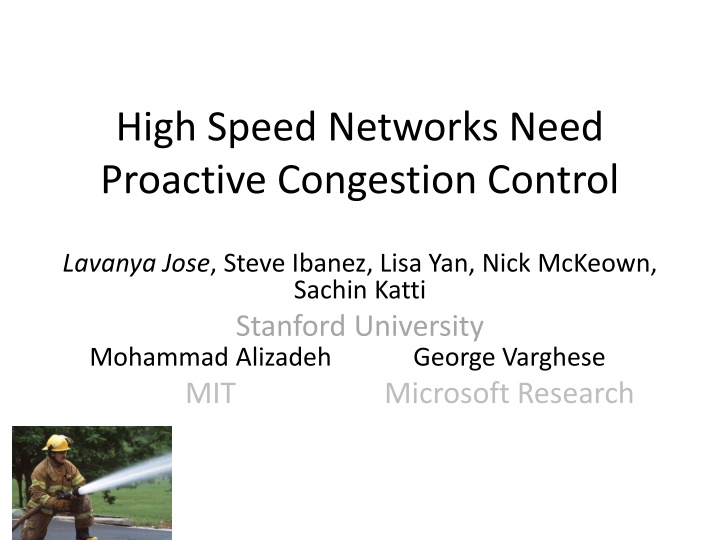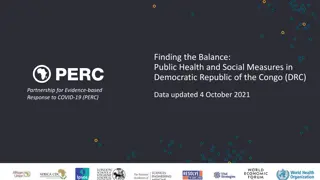
Proactive In-Network Congestion Control for High-Speed Networks
This research examines the need for proactive congestion control in high-speed networks, proposing new approaches to achieve faster adjustment of flow rates and measure congestion. The study discusses traditional congestion control methods, the advantages of explicitly calculating rates based on traffic matrices, and explores fair sharing strategies for network links. It also delves into in-network congestion control possibilities, especially in the context of re-configurable switch chips, ultimately suggesting the deployment of a robust and proactive scheme in data centers using this technology.
Download Presentation

Please find below an Image/Link to download the presentation.
The content on the website is provided AS IS for your information and personal use only. It may not be sold, licensed, or shared on other websites without obtaining consent from the author. If you encounter any issues during the download, it is possible that the publisher has removed the file from their server.
You are allowed to download the files provided on this website for personal or commercial use, subject to the condition that they are used lawfully. All files are the property of their respective owners.
The content on the website is provided AS IS for your information and personal use only. It may not be sold, licensed, or shared on other websites without obtaining consent from the author.
E N D
Presentation Transcript
High Speed Networks Need Proactive Congestion Control Lavanya Jose, Steve Ibanez, Lisa Yan, Nick McKeown, Sachin Katti Stanford University Mohammad Alizadeh MIT George Varghese Microsoft Research
At 100 Gb/s the network will be very dynamic and a typical flow will finish in just a few RTTs. Fraction of Total Flows in Bing Workload 14% Small (1-10KB) 30% 1MB / 100 Gb/s = 80 s Medium (10KB-1MB) 56% Large (1MB-100MB)
Traditional congestion control: react to congestion signals to adjust flow rates. Take tens of RTTs. Adjust Flow Rate We need new faster approaches. Measure Congestion
Explicitly calculating rates in the network based on the traffic matrix can be much faster. (Example)
Fair Share for a Single Link flow A demand Capacity at Link 1: 30G So Fair Share Rate: 30G/2 = 15G B 15 G Link 1 30 G Flow A Flow B
A second link introduces a dependency flow A demand B 10 G Link 1 30 G Link 2 10 G Flow A Flow B
In-network congestion control is promising in the context of re- configurable switch chips. Queues Action Macro Action Macro Action Macro Action Macro Fixed Action Fixed Action Fixed Action Match Table Match Table Match Table Match Table Fixed Action IPv6 Table IPv4 Table ACL Table L2 Table Parser 7
PERC Control Packet For Flow B d| | f| ? | ? Link 1 30 G Link 2 10 G Flow A Flow B
It is possible to deploy a robust, pro-active, in-network congestion control scheme in DCs with re-configurable switch chips.
PERC FPGA prototype P4 Front end PX Xilinx SDNet Compilation NetFPGA SUME Switch
Some food for thought 1. Congestion Control at 100 Gb/s - Metrics? Approaches? 2. Constraints of Re-configurable Switch Chips at 100 Gb/s speeds - Per-packet compute, Per-flow state, New Abstractions? 3. Deploying Robust Pro-active Schemes - Handling errors from control packet loss, inaccurate demand estimates







